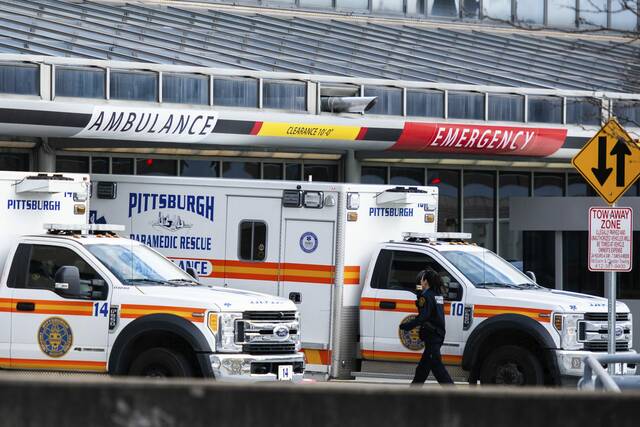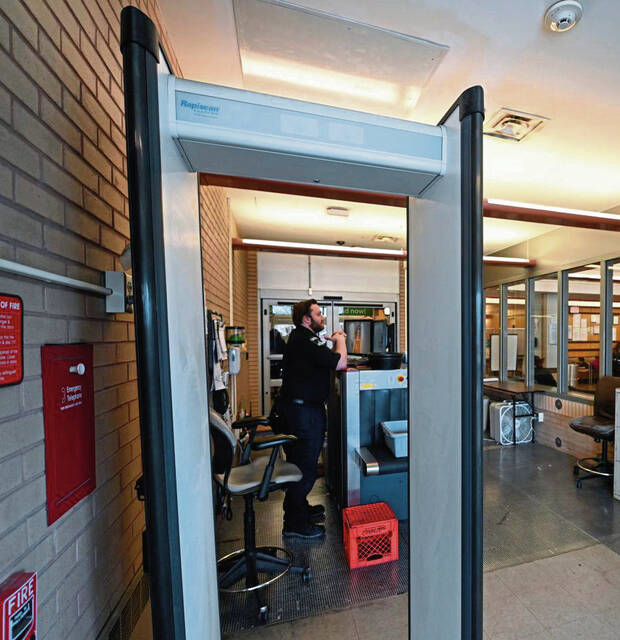In wake of York shooting, security experts see no perfect cure for hospital violence
When Andy Armenta learned of the hostage situation unfolding at UPMC Memorial hospital in York County, he immediately thought of his brush with hospital violence 25 years ago in California.
Armenta, a biomedical engineer, was on the first floor of West Anaheim Medical Center the morning of Sept. 15, 1999, when there was a Code Gray: an irate patient.
As he made his way to a stairwell, the director of the hospital’s pharmacy rushed past him. By the time Armenta hit the middle of the staircase, he heard, “pow, powpowpow.”
Within minutes, three of Armenta’s colleagues, including the pharmacy director, were dead.
“I went home to my mom and dad and cried in their arms,” Armenta, 62, recalled last week, speaking from his home near Anaheim.
Flash forward to Feb. 22, when a man entered UPMC Memorial in York with a pistol and zip ties. He took staff members hostage in the intensive care unit, killed a police officer and wounded five people before being shot dead.
Although shootings like the ones in York and Anaheim are rare among the nation’s 6,093 hospitals, for Armenta and everyone else in the health care industry, they’re all too frequent.
The incident in York, which remains under investigation, shows that even with a battery of precautions — from metal detectors to security guards to hospital police forces — danger is ever present.
“We hospital workers are vulnerable to this anywhere, and it will continue,” Armenta said.
It’s not just outlier events such as shootings that worry hospital staff. Workplace violence is routine in medical facilities and represents a chronic and growing problem.
“What happened at UPMC York is an extreme example but, unfortunately, not a unique example,” said state Rep. Arvind Venkat, D-McCandless, who is an emergency physician. “I’ve had patients who’ve taken swings at me, patients who have threatened me, patients who have been violent toward nurses. It’s scary. What should be a therapeutic environment becomes challenging.”
Venkat, who has been a doctor for nearly 25 years, continues to practice in the Pittsburgh area. He believes that maintaining security in a hospital setting should be the No. 1 priority of any facility.
“If we’re not safe in delivering care,” he said, “we’re not going to be able to do anything else.”
No fix is fail-safe
A study published in the Annals of Emergency Medicine found 154 hospital shootings in the U.S. from 2000 to 2011 — fewer than 13 per year spread across thousands of facilities. Another study in the journal Work covering 2012 to 2016 tallied 88 shootings.
They’ve occurred in Idaho, Oregon, Oklahoma, Texas, Georgia — and Pennsylvania.
On March 8, 2012, a man with schizophrenia walked into UPMC’s Western Psychiatric Institute and Clinic in Oakland in the middle of the day and killed therapist Michael Schaab, 25, of Regent Square and wounded five others. The gunman was shot to death by University of Pittsburgh police.
In the months that followed, UPMC outlined a number of security changes at its facilities in Oakland.
The hospital system instituted a 24-hour presence by Pitt police officers, installed metal detectors, constructed bullet-resistant barriers at reception areas and put in an employee-only entrance.
UPMC committed $10 million to the upgrades.
But experts said no fix is fail-safe.
“There’s never a 100% solution,” said Daniel Yaross, president of the International Association for Healthcare Security and Safety. “Things happen. Even in the most secure type of environment. If someone does have the intent, and they have the opportunity and capability, that’s where something serious can happen.
“It’s building your security layers and using a lot of collaboration.”
Local hospital systems, including UPMC, declined to provide many details about their security. In a statement, Susan Manko, a UPMC spokesperson, said their armed police officers and security teams are devoted to keeping employees safe.
Independence Health System would not answer questions for this story but issued a statement saying they “continually monitor, review and enhance our security measures to maintain a safe environment across all our facilities.”
At Allegheny Health Network facilities, there are metal detectors at every emergency department entrance, as well as at additional high-traffic entrance locations at several hospitals, including Allegheny General Hospital, West Penn, Jefferson and Saint Vincent, said spokesman Dan Laurent.
Violence ‘part of the job’
Elizabeth Barrall Werley, president-elect of the Pennsylvania College of Emergency Physicians, lives 20 minutes from UPMC Memorial. She learned about the shooting from an EMS alert on her phone.
“It was heartbreaking to see something close to home,” said Werley, an emergency physician at Penn State Health Hershey Medical Center.
Twelve hours later, Werley learned a nurse she’d worked with was in the ICU during the attack.
“That was a real gut punch,” Werley said.
While the incident deeply disturbed Werley, it hardly surprised her.
In her 20 years of experience in emergency medicine, violence and health care have gone hand in hand. During much of her career, staffers who were subjected to workplace violence were encouraged to let it go.
The thinking was, “It’s part of the job,” Werley said. She believes reported cases are on the rise “because people are being more vocal about it.”
According to the U.S. Occupational Safety and Health Administration, workers in the health care and social assistance field face a risk of workplace violence that is nearly six times greater than all other industries. The American Nurses Association reports that 1 in 4 nurses are assaulted at work.
In a push for legislation on the issue, the Pennsylvania Association of Staff Nurses & Allied Professionals collected stories from across their 11,000 members to illustrate the problem.
The examples are many and horrific:
• A medical technician in a psychiatric unit whose ring finger was gnawed off by a patient and couldn’t be reattached.
• A nurse punched so severely that she required reconstructive surgery and sustained a brain injury.
• An emergency room nurse attacked by a patient who dislocated her thumb and bit her so badly she had to undergo blood testing for months to check for HIV and hepatitis. That’s because the patient left the hospital before any blood work could be run.
State Rep. Leanne Krueger, D-Delaware, has introduced legislation in Pennsylvania’s House every year since 2019 to try to address health care workplace violence. Her bill has never come to a full vote, but she hopes that will change this session.
The legislation would require facilities to create a workplace violence committee, perform a risk assessment, undertake quarterly reviews of workplace violence incidents and offer post-incident care for employees affected by workplace violence.
“For every incident like that that shows up in the news, there are many other health care professionals experiencing violence on the job,” Krueger said.
Werley said she believes Krueger’s bill hasn’t passed because of the potential costs associated with it.
“It’s very hard to implement,” Werley said. “It’s unclear where the funding will come from. There are, perhaps, other priorities in health care that are placed above the safety of health care staff.”
Emotions run high
Security experts say having a safe environment begins at the top.
“It starts with security culture that has to emanate from C-suite and permeate down,” Yaross said. “It’s everybody’s role to take it seriously.”
He invoked the mantra of “see something, say something.”
Yaross preaches de-escalation training for hospital personnel, being empathetic, listening well and offering reassurance to patients or visitors who are distraught.
In the York case, the man identified as the shooter, Diogenes Archangel-Ortiz, 49, appeared to have been a visitor. He had recent contact with ICU staff for “for a medical purpose involving another person,” according to the local district attorney.
Emotions run high in hospitals, Werley said, especially in the ICU and emergency departments.
“It can literally be life and death,” she said. “Delivering bad news to patients is never easy.”
Technology like video cameras and access control systems can play critical roles in protecting hospital staff, according to Yaross.
“It’s multiple rings of security to get to the most secure areas of the hospital,” he said.
Bryan Warren, who has worked for more than 30 years in health care security, said improvements in technology have helped.
“But there’s a misconception that technology can replace the appropriate number of well-trained security officers,” Warren said. “A great video system can’t reach out and stop the person doing something wrong.”
Entrances into facilities should be limited, Yaross said. Visitors should be screened at the door to determine whether they have a valid reason for entering the facility.
“No one should be able to walk through the front door and get to patient areas without being escorted or having a security badge,” Yaross said. “Our goal is stop the issue at the door and not let it get past the entrance.”
But even that isn’t foolproof, Yaross noted.
“That doesn’t mean there couldn’t be a violent actor at the door,” he said.
Yaross noted many facilities have armed security officers — or even their own a police force. Locally, Allegheny Health Network and UPMC have police departments with sworn officers able to make arrests.
Geisinger, a health system in Central and Northeastern Pennsylvania, this month swore in 10 police officers who will work exclusively on their properties. They will carry guns and nonlethal weapons.
“Everyone deserves a safe and secure healing and working environment,” said Sean McGinley, Geisinger’s associate vice president of security operations and a former Pennsylvania state trooper. “Trends across the health care industry show a rising incidence of violent events in health care settings and specifically toward health care workers over the past few years, something we all have been reminded of recently.”
Trade-off for security
Other improvements Geisinger has made over the past five years include installing metal detectors in emergency rooms, adding hundreds of security cameras across its campuses — many of which use artificial intelligence to automatically alert staff to real-time dangers — and implementing specialized staff training and a K-9 program.
Geisinger also has given staff special badges that have emergency buttons to call for help.
Security experts said metal detectors are not overly costly because they are a one-time expense, but they can be difficult to staff, especially in facilities with numerous entrances.
Another consideration: There’s no one-size-fits-all solution. What’s good for one facility — say, a hospital in an urban setting — might not fit in a rural one.
“Every hospital is different. Every situation is different,” Warren said.
There is also a perception, according to Yaross, that metal detectors indicate an unsafe environment.
“The problem is health care has for many decades been viewed to be friendly, welcoming and a safe haven,” Yaross said. “Things have really changed. Violence has dramatically increased in the last couple decades.”
But metal detectors are prevalent in society now — at airports, schools and even in churches.
“People are willing to trade some convenience for safety and security,” Warren said.
Werley believes there should be metal detectors at every hospital door.
“We have to overscreen to keep our patients, our staff and ourselves safe, and I know that’s a very expensive venture,” she said. “But we can’t afford to miss another one.”
Paula Reed Ward is a TribLive reporter covering federal and Allegheny County courts. She joined the Trib in 2020 after spending nearly 17 years at the Pittsburgh Post-Gazette, where she was part of a Pulitzer Prize-winning team. She is the author of "Death by Cyanide." She can be reached at pward@triblive.com.
Remove the ads from your TribLIVE reading experience but still support the journalists who create the content with TribLIVE Ad-Free.




